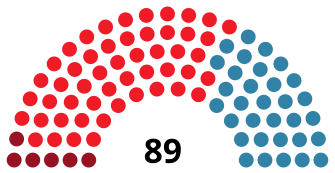| |||||||||||||||||||||||||||||||||||||
All 89 seats in the Corts Valencianes 45 seats needed for a majority | |||||||||||||||||||||||||||||||||||||
|---|---|---|---|---|---|---|---|---|---|---|---|---|---|---|---|---|---|---|---|---|---|---|---|---|---|---|---|---|---|---|---|---|---|---|---|---|---|
| Opinion polls | |||||||||||||||||||||||||||||||||||||
| Registered | 2,654,967 | ||||||||||||||||||||||||||||||||||||
| Turnout | 1,931,142 (72.7%) | ||||||||||||||||||||||||||||||||||||
| |||||||||||||||||||||||||||||||||||||
| |||||||||||||||||||||||||||||||||||||
A regional election was held in the Valencian Community on Sunday, 8 May 1983, to elect the 1st Corts of the autonomous community. All 89 seats in the Corts were up for election. It was held concurrently with regional elections in twelve other autonomous communities and local elections all throughout Spain.
Contents
- Overview
- Electoral system
- Election date
- Opinion polls
- Results
- Overall
- Distribution by constituency
- Aftermath
- References
The Spanish Socialist Workers' Party (PSOE) won the election with an absolute majority of 51 out of 89 seats and almost one million votes (51.4% of the vote). The People's Coalition, composed in the Valencian Community by the People's Alliance (AP), the People's Democratic Party (PDP), the Liberal Union and the Valencian Union (UV), became the second political force and the main opposition party in the Corts Valencianes with 32 seats. The Communist Party of Spain (PCE) managed to surpass the 5% regional threshold and entered the Corts with 6 seats, seeing a slight recovery from its results in the October 1982 general election. [1] [2]
As a result of the election, regional PSOE leader Joan Lerma became the first democratically elected president of the Valencian Government. [3]




